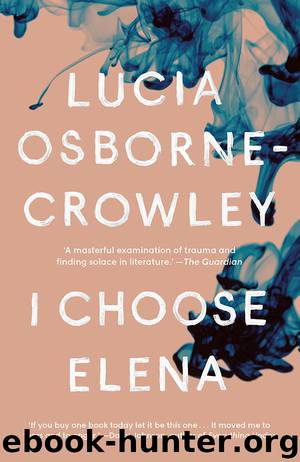I Choose Elena by Lucia Osborne-Crowley

Author:Lucia Osborne-Crowley [Lucia Osborne-Crowley]
Language: eng
Format: epub
Publisher: Allen & Unwin
Published: 2019-12-19T00:00:00+00:00
Once you heard that Shame is the closest thing to Death.
Once you said you in a poem when you were too ashamed to say I have wished to give my life back to my mother
In a long dark box.
Shame really is the closest thing to death.
In the course of my recovery I have thought a lot about the nature of shame. How it is forced upon us by others; how it feels so personal but never belonged to us in the first place.
Once, sitting on a plane on my way to visit my sister and her new life in London, I stumbled upon a lecture by social scientist Brené Brown about the difference between shame and guilt, and it felt as though some fundamental truth about myself crystallized in one fell swoop.
Guilt and shame, she explained, are profoundly different emotions. Guilt is the feeling that you have done something bad; shame is the feeling that you are bad. Guilt is internally constructed, based on our knowledge of ourselves and the recognition that our behaviour has deviated from that self; shame, on the other hand, is given to us by others. Shame is inorganic.
Guilt says, I made a mistake.
Shame says, I am a mistake.
Guilt requires us to recognize that we have acted in a way that we regret, in a way that is out of character. This process is impossible for those who live with shame: for us, shame is our character.
There is no sense in which we can act in a manner that is ‘unlike ourselves’ when we have no ‘self’ to speak of. Shame devours us from the inside out and leaves us empty: with no solid form, no edges, no boundaries, no structure.
This is known in trauma literature as a lack of ‘self-leadership’. When a person’s development is defined by, or interrupted by, violence, they become unable to develop a clear sense of self. This is because their interiority – their capacity to make decisions, to understand what they want and don’t want in the world – can only develop in an environment of safety. It is only in safe places that they can look inward. When their lives are beset by violence, they do not have that luxury.
As a traumatized child, you become accustomed to having to protect yourself, which means having a razor-sharp awareness of everything around you. You have to be able to sense danger from a mile away. You become hyper-vigilant.
Once you experience this fight, flight, freeze response, particularly in a truly life-threatening situation, it lives on in your body and resurfaces again and again in everyday life. Scientists call this a false positive bias: once you learn how perilous the world can be, you will interpret every single moment of ambiguity as danger.
Hyper-vigilance is very sensible from an evolutionary perspective. But when trauma becomes chronic and hyper-vigilance becomes a way of life, it is this very survival instinct that ironically keeps us from living in any meaningful sense of the word. We become a bundle of reactions, with no internal core, moulded together by circumstance.
Download
This site does not store any files on its server. We only index and link to content provided by other sites. Please contact the content providers to delete copyright contents if any and email us, we'll remove relevant links or contents immediately.
Cecilia; Or, Memoirs of an Heiress — Volume 1 by Fanny Burney(31444)
Cecilia; Or, Memoirs of an Heiress — Volume 3 by Fanny Burney(31035)
Cecilia; Or, Memoirs of an Heiress — Volume 2 by Fanny Burney(30982)
The Great Music City by Andrea Baker(22896)
We're Going to Need More Wine by Gabrielle Union(18124)
Bombshells: Glamour Girls of a Lifetime by Sullivan Steve(13157)
Pimp by Iceberg Slim(12999)
All the Missing Girls by Megan Miranda(12834)
Fifty Shades Freed by E L James(12491)
Talking to Strangers by Malcolm Gladwell(11983)
Norse Mythology by Gaiman Neil(11960)
Crazy Rich Asians by Kevin Kwan(8410)
Mindhunter: Inside the FBI's Elite Serial Crime Unit by John E. Douglas & Mark Olshaker(7897)
The Lost Art of Listening by Michael P. Nichols(6531)
Enlightenment Now: The Case for Reason, Science, Humanism, and Progress by Steven Pinker(6447)
Bad Blood by John Carreyrou(5816)
The Four Agreements by Don Miguel Ruiz(5577)
Weapons of Math Destruction by Cathy O'Neil(5094)
We Need to Talk by Celeste Headlee(4920)
